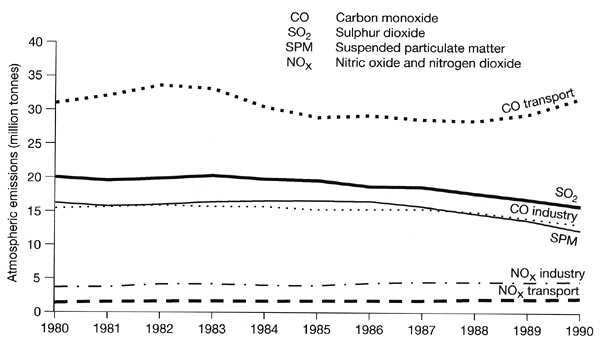Please put an active hyperlink to our site (www.rusnature.info) when you copy the materials from this page
Environmental problems of Northern Eurasia
Air Pollution
<<< Air Pollution before 1990:
Industry and Power Generation | Environmental Problems Index
| Air Pollution after 1990: Environment in Transition
>>>
Controlling Air Quality: Cleaner Fuels
The FSU has often been accused of neglecting the environment and sacrificing
environmental concerns to production quotas (Ziegler, 1987; Jancar, 1987; Pryde, 1991;
Petersen, 1993). This can be explained but cannot be disputed. The FSU emitted more
pollution than Western countries relative to GDP (Bond, 1991). However, policies aimed at
the reduction of air pollution have been pursued and while some were controversial, others
proved successful. A very significant positive step was the upgrading of outdated
industrial plants (many used equipment dating back to the 1930s or acquired from Germany
and its allies at the end of the Second World War) and removal of heavy industry away from
large administrative cities, which continued since the 1970s albeit slowly. Among the
controversial measures of air pollution reduction is the so-called 'high-stack policy'
adopted by many industrial countries in the 1970s: in order to disperse pollutants from
chimneys more efficiently, 100-200 m tall chimneys were constructed. A shift away from
domestic solid fuels towards centralized power generation and heating have certainly
helped to improve urban air quality and it should be facilitated in towns of the Asiatic
part of the region where domestic heating is still an important source of pollution
including toxic pollution. However, tall chimneys contribute significantly to the
acidification of precipitation and ecosystems downwind and need to be combined with other
more active pollution control techniques. Post-combustion treatment of effluent gases was
required by law, however, in the early 1980s as much as 25-40 per cent of all installed
gas scrubbers and dust collectors were ineffective or inoperable and the expenditure on
air pollution abatement between 1976 and 1988 was a fraction of that in the United States
(Pryde, 1991).
Most significant reductions of acid emissions have been achieved through switching of
fuels from coal and oil to natural gas. The combustion of natural gas, often described as
the most environmentally friendly fossil fuel, generates only negligible amounts of SPM,
sulphur (hydrogen sulphide is removed from natural gases.) and aromatic hydrocarbons such
as benzo(cx)pyrene. Natural gas contains nitrogen in a form that leads to NOX emissions
that are 30 per cent lower than those for oil and 50 per cent for coal (Hill, 1997). As an
additional benefit, natural gas has a high hydrogen to carbon ratio and produces 54 per
cent of CO2 emissions of hard coal per unit of heat generated and its use may
help to curtail global warming (Hill, 1999, 2000).
In 1955, the proportion of natural gas in the total USSR fuel consumption was 2.4 per
cent; in 1987 it was 25 per cent. With regard to power generation, coal was the main type
of fuel accounting for 47 per cent of power plants' fuel balance nationwide in 1970; heavy
fuel oil accounted for 23 per cent and natural gas for 24 per cent (Sagers, 1990). The
production of oil peaked in the 1970s and its proportion in the fuel balance increased by
1980. However, in following years, the emphasis was firmly on the introduction of natural
gas and its proportion in the fuel balance increased to 50 per cent in 1990, although the
absolute consumption of coal did not change significantly. The shift to gas was especially
large in the European territory where absolute consumption of coal also declined. Already
in 1985, natural gas accounted for 80 per cent of fuel burnt by power plants in Tatarstan;
in Moscow, its share increased from 62 per cent in 1980 to 8 7 per cent in 1990 and
further to 95 per cent in 1995 (Shahgedanova and Burt, 1994; Hill, 2000). In Siberia, coal
remained the main fuel but the main supplies were expected to be from the Kansk-Achinsk
region where coal has a sulphur content of 0.2-0.4 per cent which compares favourably with
the typical Donetsk anthracite containing 1.7 per cent of sulphur. In Kazakhstan its
consumption has increased as the Karaganda and FJdbastuz coal basins have been developed.
Fuel switching from coal and oil to natural gas had undoubtedly led to a reduction in
emissions of SPM and SO2 prior to 1990 (Figure 21.4).

Fig. 21.4 Atmospheric emissions in the former Soviet Union
Russia has almost unlimited supplies of natural gas and its use will most definitely
continue to grow for price reasons, especially in the European part of the FSU. An
increase is feasible in the Far East when the Sakhalin deposits are fully exploited.
However, it is likely that coal will remain the main fuel in Siberia where major
coalfields are located and there is scope for fuel cleaning and the use of cleaner post-
and in-combustion technologies in this region. These are comprehensively reviewed by Hill
(1997, 1999, 2000).
<<< Air Pollution before 1990:
Industry and Power Generation | Environmental Problems Index
| Air Pollution after 1990: Environment in Transition
>>>
Contents of the Air Pollution section:
Other sections of Environmental Problems of Nortern Eurasia:
|
|